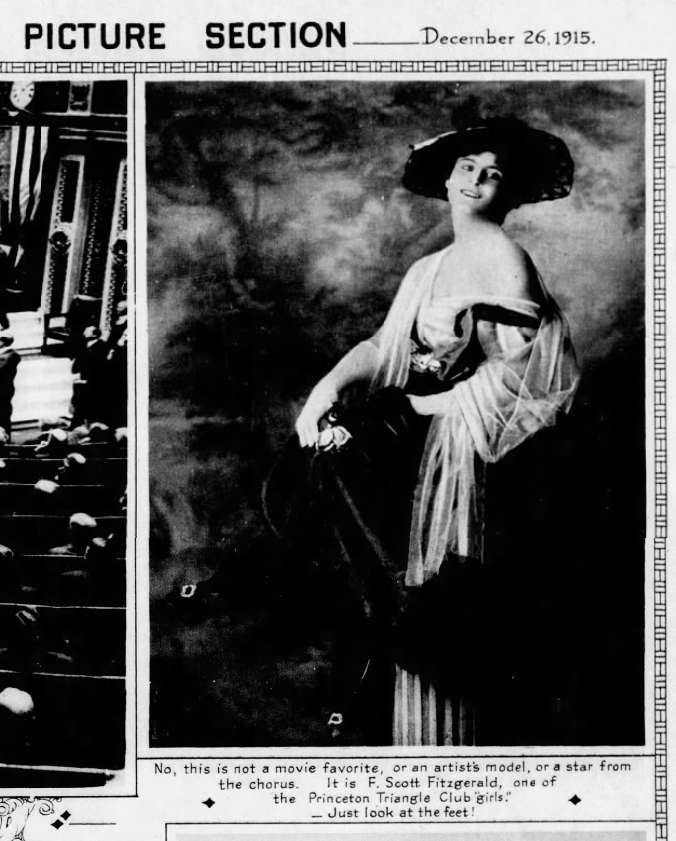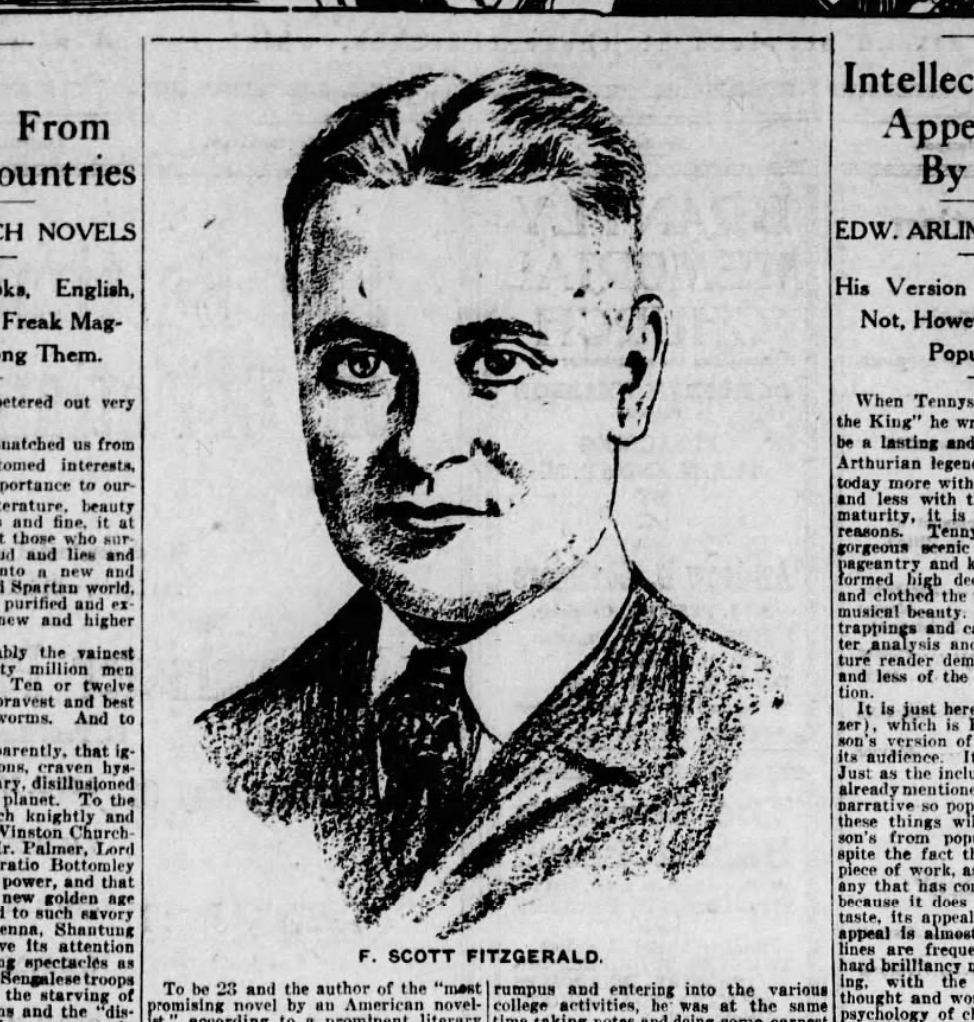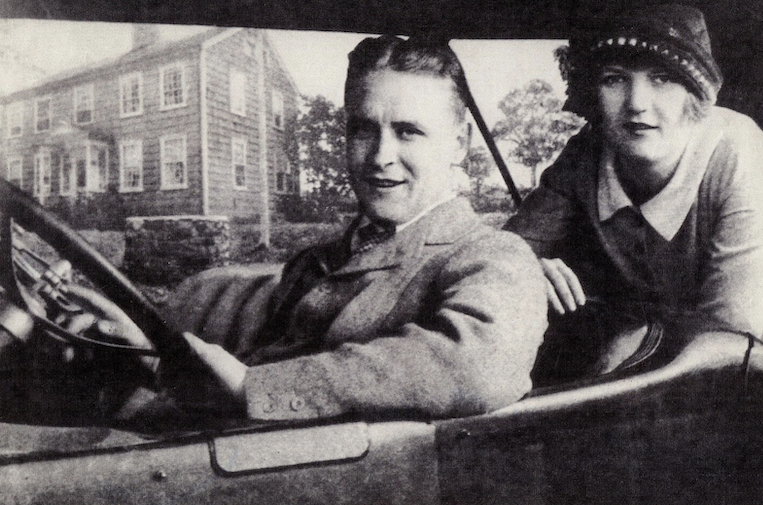Born: September 24, 1896
Died: December 21, 1940

F. Scott Fitzgerald’s first brush with fame came when he dressed as a woman …
Mr. F. Scott Fitzgerald … writer of the lyrics and a “chorus girl” in “Safety First,” makes one of the best looking girls that the Triangle Club has found. His supporters in a beauty contest state only one exception, that while his ankles are neat, they are only human, and as for the shoes, he wears a seven. Brooklyn Life, New York, December 16, 1916
Judge for yourself how Fitzgerald looked …

Fitzgerald was a member of Princeton University’s Triangle Club, which, every year, performed an original musical production written by the members. They traveled around the country during the Christmas-holiday break, performing that year’s new play. Fitzgerald wrote the lyrics for the 1914 and 1915 productions: Fie-Fie! Fi-Fi! and The Evil Eye, respectively … and was more than just a pretty face.
The lyrics of F. Scott Fitzgerald are useful to display a certain trend of thought and dialogue, as it is heard in our best clubs and the most fashionable restaurants … Mr. Fitzgerald could become one of our most overworked humorous lyric writers if he should care to continue hammering them out. The Courier-Journal, Louisville, Kentucky, December 27, 1914
Despondent over a failed romance with Ginerva King, a debutante from a wealthy family, Fitzgerald enlisted in the Army, hoping to fight in World War I. By some accounts, the heartsick soldier hoped to die in battle. He was a second lieutenant in the 67th Infantry and the war ended before his unit was shipped overseas. During his training at Fort Sheridan in Alabama, Fitzgerald met Zelda Sayre, another debutante from a wealthy family. He wanted to marry Sayre, but Zelda said she wouldn’t wed the would-be writer until he was successful.
Success can be elusive for a writer, and so it was initially for Fitzgerald, who moved to New York to pursue literary acclaim. He worked for an advertising agency, and submitted story after story to magazines, only to be met by a series of rejections. Lonely and barely eking out a living, he again thought about suicide. Desperate, he moved back to his parents’ home in St. Paul, Minnesota and revised an earlier novel that had been rejected by publishers.

And then … great success, with the publication of This Side of Paradise on March 26, 1920 …
The author of “This Side of Paradise” is a very modest young man. In spite of the fact that he has written a successful novel, at the tender age of twenty-three, that the first edition of his book was sold out almost before the ink was dry, and that one book shop sold a hundred copies of it in four hours – well, in spite of all the foregoing reasons for pride, and many others, F. Scott Fitzgerald is a shy and shrinking youth who blushes and says all the wrong things when interviewed. He has just one achievement which causes him to cast aside all reserve:
Last spring when he got out of the army he came to New York to conquer it with his pen. It is his proud boast that in the four months from March to June he received 123 rejection slips from all of our best magazines … When he had no more stories to offer to an unreceptive world he went out in the country and polished up his novel. It was a novel, by the way, which he had written while in an officers training camp during the war. Asbury Park Press, New Jersey, April 8, 1920
Here’s another review …
If you have not already done so, make a note of the name, F. Scott Fitzgerald. It is borne by a 23 year old novelist who will, unless I am much mistaken, be much heard of hereafter. His first novel “THIS SIDE OF PARADISE” (Scribner’s) gives him, I think, a fair claim to membership in that small squad of contemporary American factionalists who are producing literature … It is the only adequate study that we have had of the contemporary American in adolescence and young manhood. Chicago Tribune, April 3, 1920
The protagonist of This Side of Paradise is Amory Blaine. He’s a a handsome, spoiled young man who attends Princeton and has several ill-fated romances. So, yes, it’s based on Fitzgerald’s life.
Not everyone loved This Side of Paradise. The influential columnist/reviewer Heywood Broun wrote …
The enthusiasm in many quarters about F. Scott Fitzgerald’s “This Side of Paradise” leaves us not only cold but puzzled. New York Tribune, April 14, 1920.
Soon after Broun’s review was published, Fitzgerald’s publisher responded with this ad (take that Heywood!) …

The success of This Side of Paradise led to …
The young author was recently married to Miss Zelda Sayre, of Montgomery, a state-wide belle and beauty who is much admired in Anniston. The Anniston Star, Alabama, May 25, 1920

Scott and Zelda quickly became of the toast of the town in New York, the Jazz Age’s foremost couple. BTW: Fitzgerald was the one who coined the Jazz Age term to describe the 1920s.
No one can say the Scott Fitzgeralds ever do things by halves. Not that any one ever has so intimated. Daily News, New York, May 11, 1924
I’m going to end here, with Fitzgerald’s initial brush with literary fame and fortune. Soon after would come The Great Gatsby (1925), followed by the couple’s marital, mental-health issues and alcoholism.
If you found this story interesting, you might like to read my From Unknown to Famous stories about Mary Tyler Moore, Carol Burnett, Bruce Springsteen, Ernest Hemingway, Arnold Schwarzenegger, Marilyn Monroe, Amelia Earhart, Babe Ruth, Jackie Robinson, Elvis, Little Stevie Wonder and Alex Trebek and many more. Please subscribe to this blog and get alerts every time I post a new one (lots more are coming).

